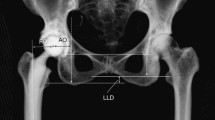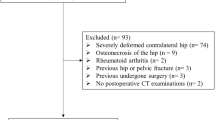Abstract
Purpose
Accurate evaluation of femoral offset is difficult with conventional anteroposterior (AP) X-rays. The EOS imaging system is a system that makes the acquisition of simultaneous and orthogonal AP and lateral images of the patient in the standing position possible. These two-dimensional (2D) images are equivalent to standard plane X-rays. Three-dimensional (3D) reconstructions are obtained from these paired images according to a validated protocol. This prospective study explores the value of the EOS imaging system for comparing measurements of femoral offset from these 2D images and the 3D reconstructions.
Methods
We included 110 patients with unilateral total hip arthroplasty (THA). The 2D offset was measured on the AP view with the same protocol as for standard X-rays. The 3D offset was calculated from the reconstructions based on the orthogonal AP and lateral views. Reproducibility and repeatability studies were conducted for each measurement. We compared the 2D and 3D offset for both hips (with and without THA).
Results
For the global series (110 hips with and 110 without THA), 2D offset was 40 mm (SD 7.3; 7–57 mm). The standard deviation was 6.5 mm for repeatability and 7.5 mm for reproducibility. Three-dimensional offset was 43 mm (SD 6.6; 22–62 mm), with a standard deviation of 4.6 for repeatability and 5.5 for reproducibility. Two-dimensional offset for the hips without THA was 40 mm (SD 7.0; 26–56 mm), and 3D offset 43 mm (SD 6.6; 28–62 mm). For THA side, 2D offset was 41 mm (SD 8.2; 7–57 mm) and 3D offset 45 mm (SD 4.8; 22–61 mm). Comparison of the two protocols shows a significant difference between the 2D and 3D measurements, with the 3D offset having higher values. Comparison of the side with and without surgery for each case showed a 5-mm deficit for the offset in 35 % of the patients according to the 2D measurement but in only 26 % according to the 3D calculation.
Conclusions
This study points out the limitations of 2D measurements of femoral offset on standard plane X-rays. The reliability of the EOS 3D models has been previously demonstrated with CT scan reconstructions as a reference. The EOS imaging system could be an option for obtaining accurate and reliable offset measurements while significantly limiting the patient’s exposure to radiation.



Similar content being viewed by others
References
Charles MN, Bourne RB, Davey JR et al (2005) Soft-tissue balancing of the hip: the role of femoral offset restoration. Instr Course Lect 54:131–141
Asayama I, Chamnongkich S, Simpson KJ et al (2005) Reconstructed hip joint position and abductor muscle strength after total hip arthroplasty. J Arthroplasty 20:414–420. doi:10.1016/j.arth.2004.01.016
McGrory BJ, Morrey BF, Cahalan TD et al (1995) Effect of femoral offset on range of motion and abductor muscle strength after total hip arthroplasty. J Bone Joint Surg (Br) 77:865–869
Sakalkale DP, Sharkey PF, Eng K, et al. (2001) Effect of femoral component offset on polyethylene wear in total hip arthroplasty. Clin Orthop Relat Res 125–134
Schmidutz F, Beirer M, Weber P et al (2012) Biomechanical reconstruction of the hip: comparison between modular short-stem hip arthroplasty and conventional total hip arthroplasty. Int Orthop 36:1341–1347. doi:10.1007/s00264-011-1477-2
Illés T, Somoskeöy S (2012) The EOS™ imaging system and its uses in daily orthopaedic practice. Int Orthop 36(7):1325–1331. doi:10.1007/s00264-012-1512-y
Than P, Szuper K, Somoskeöy S, Warta V, Illés T (2012) Geometrical values of the normal and arthritic hip and knee detected with the EOS imaging system. Int Orthop 36(6):1291–1297. doi:10.1007/s00264-011-1403-7
Chaibi Y, Cresson T, Aubert B et al (2012) Fast 3D reconstruction of the lower limb using a parametric model and statistical inferences and clinical measurements calculation from biplanar X-rays. Comput Methods Biomech Biomed Eng 15:457–466. doi:10.1080/10255842.2010.540758
Mitton D, Landry C, Véron S et al (2000) 3D reconstruction method from biplanar radiography using non-stereocorresponding points and elastic deformable meshes. Med Biol Eng Comput 38:133–139
Mitulescu A, Semaan I, de Guise JA et al (2001) Validation of the non-stereo corresponding points stereoradiographic 3D reconstruction technique. Med Biol Eng Comput 39:152–158
Le Bras A, Laporte S, Bousson V et al (2004) 3D reconstruction of the proximal femur with low-dose digital stereoradiography. Comput Aided Surg 9:51–57. doi:10.3109/10929080400018122
Mitton D, Deschênes S, Laporte S et al (2006) 3D reconstruction of the pelvis from bi-planar radiography. Comput Methods Biomech Biomed Eng 9:1–5. doi:10.1080/10255840500521786
Buck FM, Guggenberger R, Koch PP, Pfirrmann CWA (2012) Femoral and tibial torsion measurements with 3D models based on low-dose biplanar radiographs in comparison with standard CT measurements. AJR Am J Roentgenol 199:W607–W612. doi:10.2214/AJR.11.8295
Guenoun B, Zadegan F, Aim F et al (2012) Reliability of a new method for lower-extremity measurements based on stereoradiographic three-dimensional reconstruction. Orthop Traumatol Surg Res 98:506–513. doi:10.1016/j.otsr.2012.03.014
Lazennec J-Y, Rousseau MA, Rangel A et al (2011) Pelvis and total hip arthroplasty acetabular component orientations in sitting and standing positions: measurements reproductibility with EOS imaging system versus conventional radiographies. Orthop Traumatol Surg Res 97(4):3. doi:10.1016/j.otsr.2011.02.006
Folinais D, Thelen P, Delin C et al (2013) Measuring femoral and rotational alignment: EOS system versus computed tomography. Orthop Traumatol Surg Res 99(5):509-516. doi:10.1016/j.otsr.2012.12.023
Merle C, Waldstein W, Pegg E et al (2012) Femoral offset is underestimated on anteroposterior radiographs of the pelvis but accurately assessed on anteroposterior radiographs of the hip. J Bone Joint Surg (Br) 94-B:477–482. doi:10.1302/0301-620X.94B4.28067
Renkawitz T, Schuster T, Grifka J et al (2010) Leg length and offset measures with a pinless femoral reference array during THA. Clin Orthop Relat Res 468:1862–1868. doi:10.1007/s11999-009-1086-1
Sariali E, Mouttet A, Pasquier G et al (2009) Accuracy of reconstruction of the hip using computerised three-dimensional pre-operative planning and a cementless modular neck. J Bone Joint Surg (Br) 91:333–340. doi:10.1302/0301-620X.91B3.21390
Sariali E, Mouttet A, Pasquier G, Durante E (2009) Three-dimensional hip anatomy in osteoarthritis. Analysis of the femoral offset. J Arthroplasty 24:990–997. doi:10.1016/j.arth.2008.04.031
Journois D (2004) Concordance between two variables: graphical approach (Bland and Altman’s method). Rev Mal Respir 21:127–130
Rillardon L, Levassor N, Guigui P et al (2003) Validation of a tool to measure pelvic and spinal parameters of sagittal balance. Rev Chir Orthop Reparatrice Appar Mot 89:218–227
Fermanian J (2005) Validation of assessment scales in physical medicine and rehabilitation: how are psychometric properties determined? Ann Readapt Med Phys 48:281–287. doi:10.1016/j.annrmp.2005.04.004
Fuhrman C, Chouaïd C (2004) Concordance between two variables: numerical approaches (qualitative observations—the kappa coefficient-; quantitative measures. Rev Mal Respir 21:123–125
International Organization for Standardization (1994) Application of statistics—accuracy (trueness and precision) of measurement methods and results—Part 2: Basic method for the determination of repeatability and reproducibility of a standard measurement method. ISO 5725–2:1994
Rubin PJ, Leyvraz PF, Aubaniac JM et al (1992) The morphology of the proximal femur. A three-dimensional radiographic analysis. J Bone Joint Surg (Br) 74:28–32
De Thomasson E, Mazel C, Guingand O, Terracher R (2002) Value of preoperative planning in total hip arthroplasty. Rev Chir Orthop Reparatrice Appar Mot 88:229–235
Pasquier G, Ducharne G, Ali ES et al (2010) Total hip arthroplasty offset measurement: is CT scan the most accurate option? Orthop Traumatol Surg Res 96:367–375. doi:10.1016/j.otsr.2010.02.006
Guyer B, Smith DS, Cady RB et al (1984) Dosimetry of computerized tomography in the evaluation of hip dysplasia. Skeletal Radiol 12:123–127
Jonsson A, Herrlin K, Jonsson K et al (1996) Radiation dose reduction in computed skeletal radiography. Effect on image quality. Acta Radiol 37:128–133
Lattanzi R, Baruffaldi F, Zannoni C, Viceconti M (2004) Specialised CT scan protocols for 3-D pre-operative planning of total hip replacement. Med Eng Phys 26:237–245. doi:10.1016/j.medengphy.2003.11.008
Preininger B, Schmorl K, von Roth P et al (2012) Femoral offset (3D) in patients without osteoarthritis—index values from 200 hip joints. Open Orthop J 6:578–581. doi:10.2174/1874325001206010578
Deschênes S, Charron G, Beaudoin G et al (2010) Diagnostic imaging of spinal deformities: reducing patients radiation dose with a new slot-scanning X-ray imager. Spine 35:989–994. doi:10.1097/BRS.0b013e3181bdcaa4
McKenna C, Wade R, Faria R et al (2012) EOS 2D/3D X-ray imaging system: a systematic review and economic evaluation. Health Technol Assess 16:1–188. doi:10.3310/hta16140
Wade R, Yang H, McKenna C et al (2013) A systematic review of the clinical effectiveness of EOS 2D/3D X-ray imaging system. Eur Spine J 22:296–304. doi:10.1007/s00586-012-2469-7
Lazennec J-Y, Brusson A, Rousseau M-A (2012) THA patients in standing and sitting positions: a prospective evaluation using the low-dose “full-body” EOS. Semin Arthroplast 23:220–225. doi:10.1053/j.sart.2013.01.005
Wybier M, Bossard P (2012) Musculoskeletal imaging in progress: the EOS imaging system. Joint Bone Spine. doi:10.1016/j.jbspin.2012.09.018
Bourne RB, Rorabeck CH (2002) Soft tissue balancing: the hip. J Arthroplasty 17:17–22. doi:10.1054/arth.2002.33263
Tomczak RJ, Guenther KP, Rieber A et al (1997) MR imaging measurement of the femoral antetorsional angle as a new technique: comparison with CT in children and adults. AJR Am J Roentgenol 168:791–794. doi:10.2214/ajr.168.3.9057536
Sugano N, Noble PC, Kamaric E (1998) A comparison of alternative methods of measuring femoral anteversion. J Comput Assist Tomogr 22:610–614
Weiner DS, Cook AJ, Hoyt WA, Oravec CE (1978) Computed tomography in the measurement of femoral anteversion. Orthopedics 1:299–306
Reikerås O, Bjerkreim I, Kolbenstvedt A (1983) Anteversion of the acetabulum and femoral neck in normals and in patients with osteoarthritis of the hip. Acta Orthop Scand 54:18–23
Murphy SB, Simon SR, Kijewski PK et al (1987) Femoral anteversion. J Bone Joint Surg Am 69:1169–1176
Sakai T, Sugano N, Ohzono K et al (2002) Femoral anteversion, femoral offset, and abductor lever arm after total hip arthroplasty using a modular femoral neck system. J Orthop Sci 7:62–67. doi:10.1007/s007760200010
Lecerf G, Fessy MH, Philippot R et al (2009) Femoral offset: anatomical concept, definition, assessment, implications for preoperative templating and hip arthroplasty. Orthop Traumatol Surg Res 95:210–219. doi:10.1016/j.otsr.2009.03.010
Delp SL, Wixson RL, Komattu AV, Kocmond JH (1996) How superior placement of the joint center in hip arthroplasty affects the abductor muscles. Clin Orthop Relat Res 137–146
Gonzalez Della Valle A, Slullitel G, Piccaluga F, Salvati EA (2005) The precision and usefulness of preoperative planning for cemented and hybrid primary total hip arthroplasty. J Arthroplasty 20:51–58. doi:10.1016/j.arth.2004.04.016
Carter LW, Stovall DO, Young TR (1995) Determination of accuracy of preoperative templating of noncemented femoral prostheses. J Arthroplasty 10:507–513
Knight JL, Atwater RD (1992) Preoperative planning for total hip arthroplasty. Quantitating its utility and precision. J Arthroplasty 7(Suppl):403–409
Sotereanos NG, Sauber TJ, Tupis TT (2013) Modular femoral neck fracture after primary total hip arthroplasty. J Arthroplasty 28:196.e7–196.e9. doi:10.1016/j.arth.2012.03.050
Werner SD, Bono JV, Nandi S et al (2013) Adverse tissue reactions in modular exchangeable neck implants: a report of two cases. J Arthroplasty 28:543.e13–543.e15. doi:10.1016/j.arth.2012.07.026
Cooper HJ, Urban RM, Wixson RL et al (2013) Adverse local tissue reaction arising from corrosion at the femoral neck-body junction in a dual-taper stem with a cobalt-chromium modular neck. J Bone Joint Surg 95:865–872. doi:10.2106/JBJS.L.01042
Conflict of interest
The authors declare that they have no conflict of interest.
Author information
Authors and Affiliations
Corresponding author
Rights and permissions
About this article
Cite this article
Lazennec, J.Y., Brusson, A., Dominique, F. et al. Offset and anteversion reconstruction after cemented and uncemented total hip arthroplasty: an evaluation with the low-dose EOS system comparing two- and three-dimensional imaging. International Orthopaedics (SICOT) 39, 1259–1267 (2015). https://doi.org/10.1007/s00264-014-2616-3
Received:
Accepted:
Published:
Issue Date:
DOI: https://doi.org/10.1007/s00264-014-2616-3




